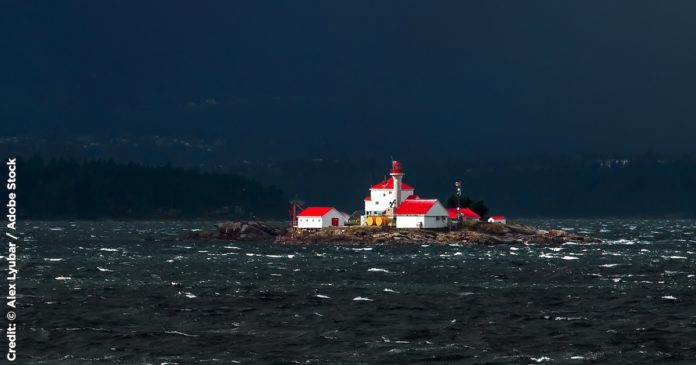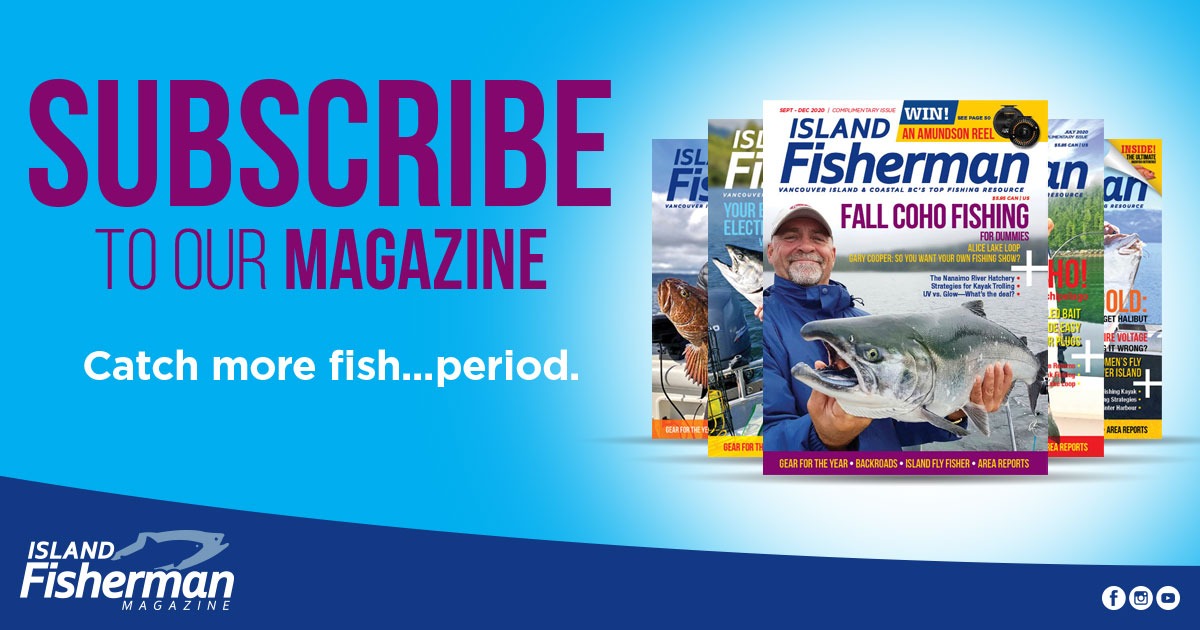Disclaimer
Marine weather can be extremely dangerous. Only experienced anglers with proper training should consider offshore boating. This article is intended only as an introduction and suggestions for consideration by the author. Island Fisherman magazine makes no statement or representation, express or implied, with respect to the accuracy, availability, completeness or usefulness of the information, contained herein, and in so far as permitted by law, will not have any legal liability or responsibility (including liability for negligence) for any loss, damage, or injury (including death) which may result, whether directly or indirectly, from the supply or use of such information.
We all have that moment we just grab the gear and run out to fish, without thinking about the weather conditions. You might luck into the best weather day you’ve ever experienced, but here on the island, you just might find yourself trapped in the storm of your nightmares. You need to be smart about the weather, and ideally, you should plan your trip 24 to 48 hours ahead of departure time. In this article, we’ll cover some basic weather and water condition prediction strategies to help plan your trip, and to keep you safe out on the ocean, lake, or river. If you are on the ocean and didn’t check any forecast, always watch for signs of building weather, like changing swell height/period and dark clouds on the horizon. This is not a detailed course on weather forecasting or when it is okay to be on the water. Always boat to your ability, and only wade in the river to your knees if you have any doubts.
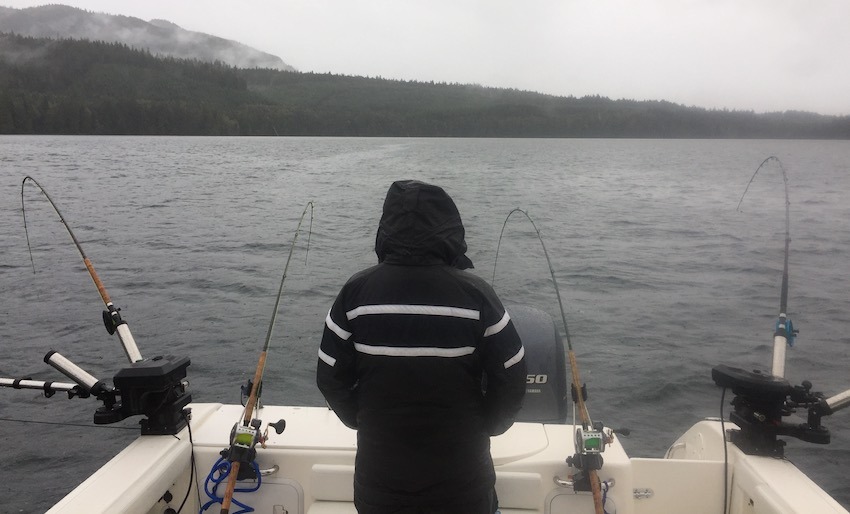
Pro Tip: If you want more info on safe boating, please consider taking Power Squadron courses, or obtaining the commercial Small Vessel Operator Proficiency (SVOP) ticket.
BC Marine Fishing Weather
There are so many factors to consider before going out fishing on the ocean. The wind (both speed and direction), the tide, and precipitation dictate if you can be out there safely. No one wants to be offshore on 3 m swells with 6-second period and 0.5 m wind chops on top, or nearshore with whitecaps.
Swell
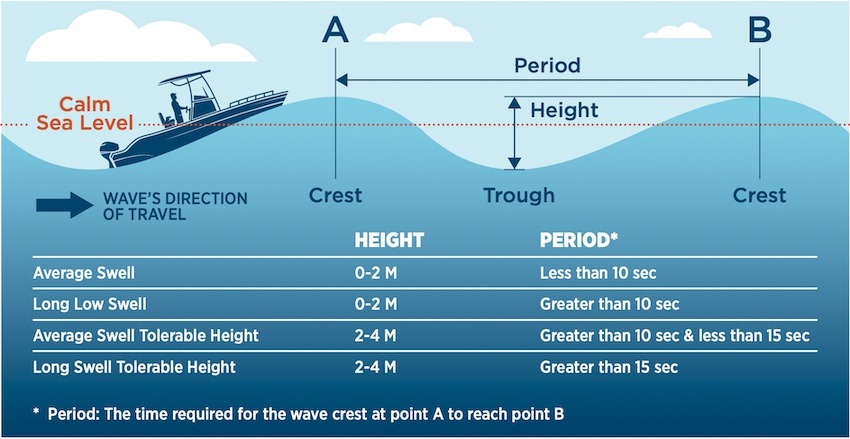
So what’s considered a tolerable swell period? Less than 10 seconds is considered short, and from 10 to 20 seconds or more is considered long. Short swell periods arise from short distance weather systems (sometimes formed from local wind waves), while a long period swell is from a system far offshore (50 nm or more). If the swell is 1 m with a 5-second period, you’ll be OK on a 21′ boat. To find the swell period—the time from the peak of one swell to the peak of the next—take the swell height in metres and multiply by five. A swell of 4 m with 15-second period is quite safe to boat in, because the long period gives you enough time to react in between the swells. You still must look at the wind waves in the area where you intend to fish. A local 15-kt wind will form 3′ wind chop waves (around a 4-second wave period) on top of the swell. On the west side of the island, you have to consider both swell and wind waves, whereas on the east side, you just need to consider wind waves. So how can you best assess the wind and wave situation before you head out? We’ll look at different forecasts and how to make an educated decision.
BC Marine Forecast
The Government of Canada Marine Forecast is the first thing to look at when planning a trip on the ocean. The government marine forecast is very accurate to a broad area, and every mariner should respect the government forecast. The forecast will provide wind velocity and sometimes wave heights (with swell periods), depending on which part of the coastal region you’ll be in.
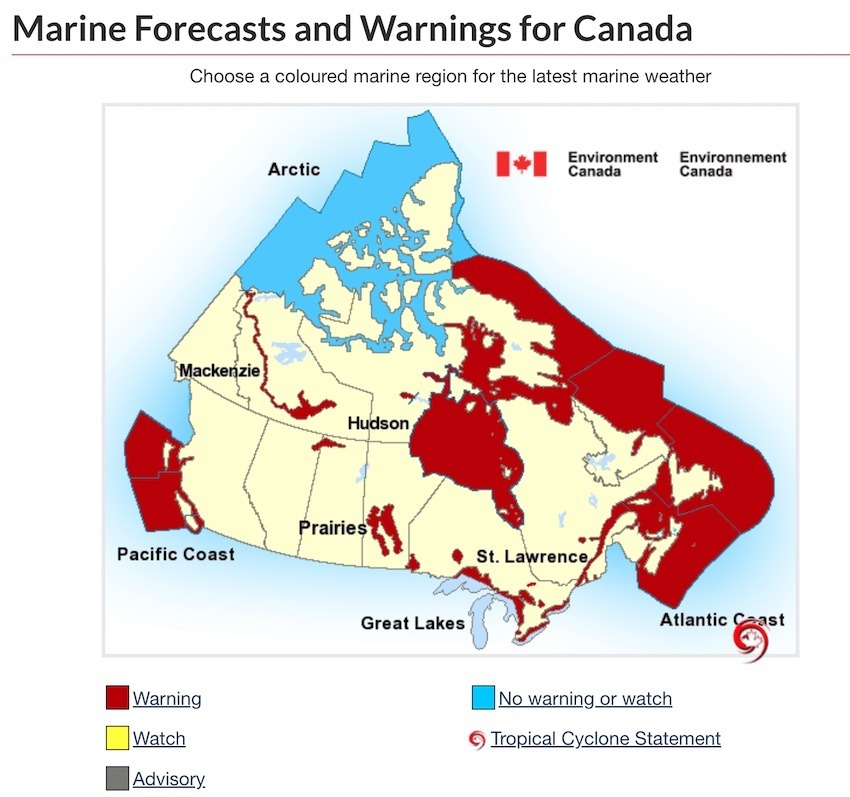
Please respect the wind warnings and boat within your abilities. If it is hard for you to get out of the marina, then it will be hard to dock your boat. If you see a Strong Wind Warning, (20 to 33 kts or 37 to 61 km/hour according to the Canadian marine warning program) sustained wind excluding gusts, you’ll know that is not great time to be on the water with a 21′ boat fishing for fun, even though your boat can handle the conditions. If you see Gale Warning on the forecast, just stay on land. Even commercial passenger vessels stay docked during Gale Warnings.
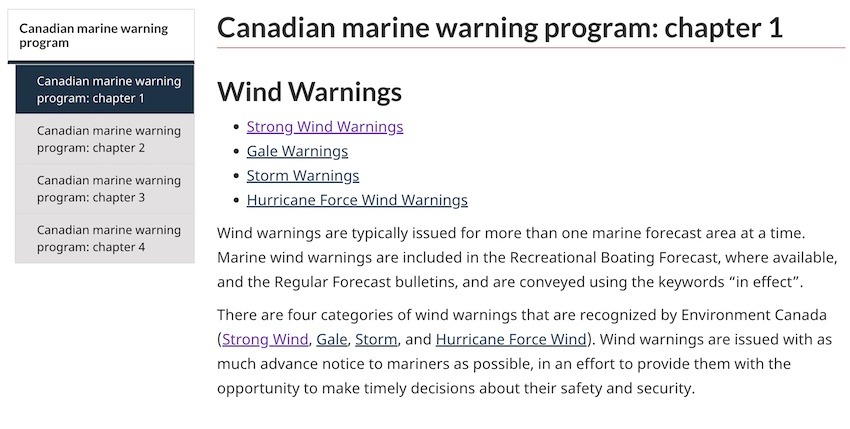
According to boat-ed.com:
“Environment Canada will issue a wind warning when high wind speeds are expected.
- Strong Wind Warning: Winds in the range of 21 to 33 knots (37 to 61 km/hour) create conditions considered dangerous to small vessels.
- Gale Warning: Winds are in the range of 34 to 47 knots (62 to 87 km/hour).
- Storm Warning: Winds are 48 to 63 knots (88 to 117 km/hour) and may be associated with a tropical cyclone.
- Hurricane Force Wind Warning: Winds are 64 knots and above (118 km/hour and above). This does not warn of a current or impending hurricane.”
The government marine forecast provides you a 7-day outlook on the wind and weather system (synopsis tab will provide some detail how the weather system is approaching the area).
Strategy For Predicting Fishing Trip Weather
Here’s my typical strategy: Any forecast over 48 hours is just a prediction of the weather system, but forecasts within 48 hours are pretty accurate. If you are planning to go out right away, look at any lighthouse current report or buoy report, along with the government-issued marine forecast. Some lighthouse and buoy reports provide you temperature, wave conditions, visibility, and weather conditions. Recreational anglers should not be out there when winds are blowing greater than 15 kts (Strong Wind Warning). That is when whitecaps form and the waves are typically 3′, which is uncomfortable for some boaters.
Sample: Click here for Race Rocks Lightstation Current Report
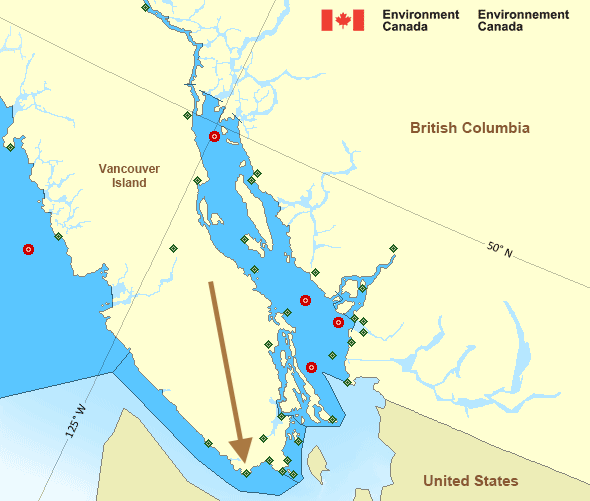
Sample: Click here for La Perouse Bank – 46206
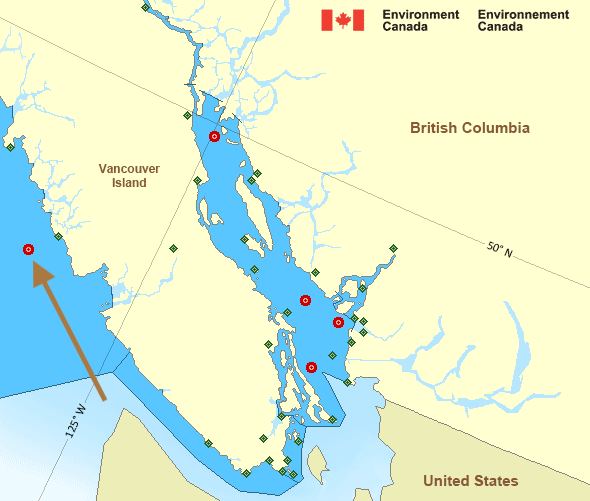
Weather Network Marine Forecast
The Weather Network marine forecast is a quick overview 48-hour forecast with weather conditions updated hourly. Many coastal towns will have a marine forecast or lighthouse forecast in the Weather Network.
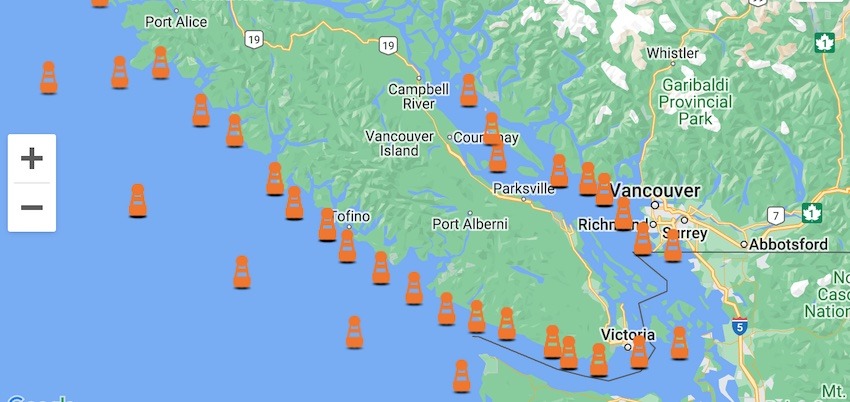
The website will provide you a 48-hour outlook on the wind forecast and government of Canada marine forecast information below. It’s a basic one-stop spot to grab your marine forecast for the next 24 hours and head out for nearshore ocean fishing. It does not provide you with the most detailed prediction for exactly where you will be on the water, especially offshore.
Around the coastal region, southeast winds mean a low-pressure system is coming. This usually brings strong winds (depends on how tight the pressure gradient lines) and some rain. This wind direction tends to happen during the fall and winter months for the Pacific Northwest. Northwest wind means a high-pressure system is coming, and so sunny skies are pushing into the area. There are a couple of weather modeling systems in Windy. The ones we should use around southern BC are the NAM (North American Mesoscale) and ECMWF (European Centre of Medium-Range Weather Forecasts) modeling systems because of the resolution. NAM has the most accuracy for the southern BC and the US. NAM updates its forecast 4 times a day with around 5-km resolution (the resolution may vary). For the rest of BC, the most accurate modeling is ECMWF. ECMWF updates 2 times a day with 9-km resolution (again, it may vary). With NAM, you can see accurate wind and weather prediction within a 48-hour window. Sport anglers should look for wind readings of 0 – 15 kts in any wind direction.
Windy Website & App
Windy predicts waves as well as wind. After looking at wind for a specific region you are planning to fish, you can switch over to wave prediction at the bottom of the browser window or app—it’s a great tool to assess what the water condition is within the modeling system. Swell indicates the main offshore buildup wave. Swell 2 indicates the secondary offshore buildup wave. Swell 2 can be viewed as wind fetch swell for San Juan Strait, Strait of Georgia, Johnstone Strait, and other sheltered water. You’ll also find the total wave height listed in the bottom chart. Again, the longer period between swells, the better.
In my experience, periods more than 12 seconds and swells less than 3 m indicate smooth water out offshore. The tighter the swell period, the heavier the swell condition. When Swell and Swell 2 periods are quite long, that indicates a calm water day offshore before factoring in the local wind waves. As mentioned before, 15-kt wind generally produces 3′ waves with whitecaps in the straits (caused by local winds and swell from far distance fetch). Wind waves are more pronounced in the straits just because of the funnelling effect and the underwater terrain with against-tide current.
Predict Wind Website & App
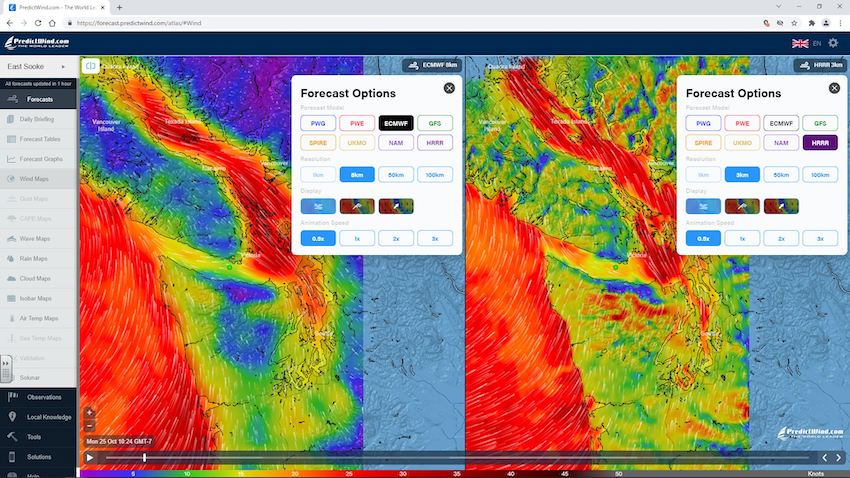
The Predict Wind site/app is a great tool to look at wind predictions, and it shows wind in higher resolution than Windy does. You will have to crate an account (even free), though. As far as I know, Predict Wind has the highest resolution wind forecast available for free to the public. The HRRR (High Resolution Rapid Refresh) is NOAA real-time 3-km resolution updated hourly. It also has all the other wind models that Windy has and more. The HRRR wind forecast is great forecasting tool, but it is only available for southern BC and the US with HRRR modeling. Predict Wind has wave modeling forecasts just like Windy does.
Tide Direction and Wind
Tide direction and wind can amplify some local standing waves, usually near spits, narrows, and humps. After understanding all the marine forecasts in the area you want
to fish, you still need a bit of local knowledge of the area; for instance, you do not want to fish with a little southeast wind and flooding tide at the Campbell River hump, and you should be extremely careful fishing the Narrows with a northwest wind building up into the afternoon, causing roller waves coming down the Narrows. A northwest wind with ebbing tide at the Buoy P61 can cause some uncomfortable fishing conditions, too. If the tide and wind are in the same direction, the waves are not as amplified. It might even smooth out the water surface sometimes. Use the local terrain structures (mountains, cliffs, and buildings) to help you block the wind, creating some sheltered fishing or boating.
Marine Weather Webcams
There are many webcams that can help plan and prepare for your boating trip. Big Wave Dave, now WindIsGood.com website has a list of different webcams available to get a glimpse of the water condition. Even though the site was built for surfers, it’s useful for us anglers, too.
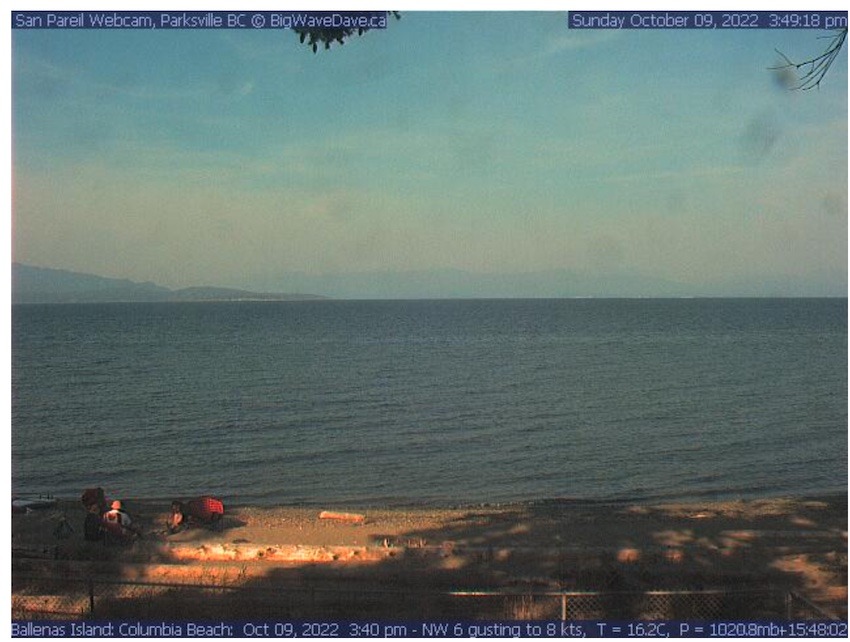
If you do not see your webcam view from the main page, you can select the “webcam” tab and see other shots from around Vancouver Island. Some of the webcam locations also have some wind and government marine forecast data.
As you can see, you should spend a lot of time planning and researching before going out boating and fishing. Always look at the weather where you plan to be, then look beyond 10 nm out from the spot for incoming weather systems. It’s a good practice.
Weather For Lake Fishing
Some larger and longer lakes can behave like the ocean. Smaller lakes usually are in a sheltered area where the wind does not really cause swell or major wind chops. You should still check out the weather and wind forecasts to plan your fishing trips on the local lakes.
Using land-based forecast locations to help predict the weather and wind condition near the lake is a good strategy. Most urban lakes are close to a school or airport, and you can use the Weather Network to search for the nearest town or city weather forecast to provide you a wind and weather forecast.
I find the airport forecast current condition for wind is more up to date than the beach, school, or golf/parks weather forecast. These forecasts will be accurate within 48 hours. It’s a reliable forecast for grab-and-go fishing, but if you are fishing in bigger lakes, you need more details.
For bigger lakes, Windy and Predict Wind are powerful tools to help plan your trip. I find the big lakes on Vancouver Island have waves and swell forecasts just like the ocean. Nimpkish Lake, Woss Lake, Buttle Lake, Campbell Lake, Comox Lake, Nitinat Lake, Cowichan Lake, Great Central Lake, Sproat Lake, Shawinigan Lake, and Elk Lake all have waves/swell forecasts in Windy. If you know the lake is open to northwest wind, then you know there is enough wind fetch distance to build up waves on the water. Avoid fishing when the wind is over 15 kts.
River Fishing Weather—Hydrometric Data
For a river fishing weather forecast, you’ll just need to know how to interpret the normal weather forecast to see how river water level/flow and clarity will change. You can use all the aforementioned forecast sites and apps to help plan your trip. The wind does not really affect whether or not you can fish; it just makes casting a little more difficult. Of course, you should not really be standing in the river fishing while there is a thunderstorm with lightning in the area.
Government of Canada Water Office Real-Time Data
The main thing to look at while river fishing is the water level and flow. Every year there is an angler drowning because of a rising river or slipping into deep water while wading. If you are wading, make sure you tighten your wading belt snugly. Use a wading stick to help find your way walking in the river. Most river fishing drownings occur when waders fill with water and pull the angler down. Every river has a different personality, so you’ll want to build up your local knowledge on the rivers that you fish. The best way to learn about the river where you fish, is from live and historical data.
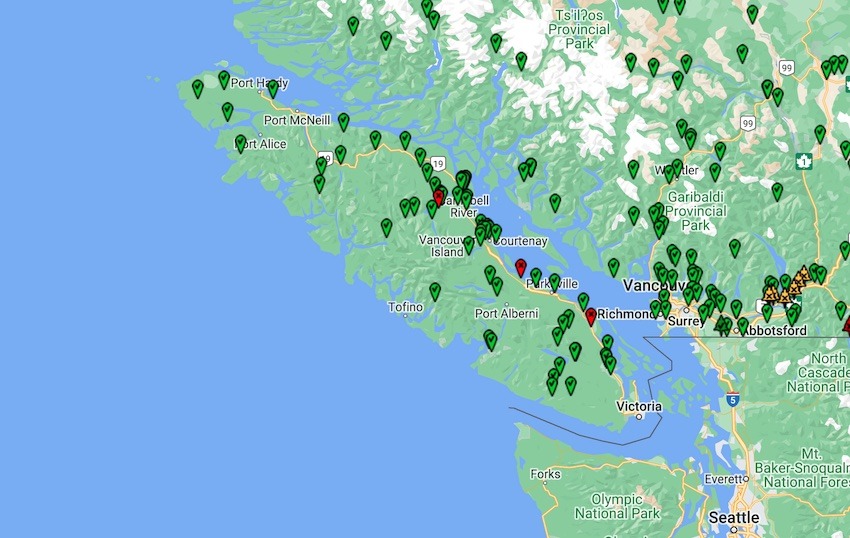
Government of Canada Water Office Real-Time data website is the best reliable data you can find free. When you see a large amount of rain forecast within 24 hours, usually the next day you’ll see a blown out (high and fast moving water) and browned out (clarity of water like milk tea or milk coffee colour) river. If rain is forecast within 12 hours before you go fish, the river water clarity usually will be fishable (green tea colour) and water level will be rising. Fishing while it begins to rain is great. The rain introduces fresh water and air, which triggers the salmon to swim upstream. Just keep an eye on the water level (by placing rocks near you for visual checks) while wading in the river so you don’t get trapped in the river. So before you head out of the house and fish, you should check the river real-time data (if the river has a recording), looking for a flow/level that is dropping, steady or slowly rising. Use the data and weather conditions to build up your local knowledge of the river every time you fish there.
This article appeared in Island Fisherman magazine. Never miss another issue—subscribe today!


